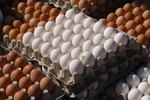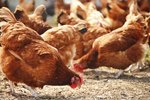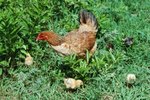Chicken fanciers call partridge rock chickens by the name partridge Plymouth Rock chickens. Plymouth Rock chickens come in several colors including partridge, white, barred, Columbian, buff, blue and silver penciled. Plymouth Rocks are a popular dual-purpose bird among small flock owners and lay brown eggs.
Origins
D. A. Upham of Worcester, Massachusetts bred the first Plymouth Rock in 1869. He created this new breed by crossing a mutt chicken with barred feathers and a single comb with Black Java mixed hens. The result was the barred Plymouth Rock. Partridge Plymouth Rocks appeared in the late 1800s and early 1900s, with at least three different lines. The partridge coloring came from breeders introducing partridge cochin chickens into their lines.
Size
The Plymouth Rock comes in two sizes: standard and bantam. Standard-size roosters weigh about 9.5 pounds. Standard-size hens weigh about 7.5 pounds. Bantam roosters weigh about 36 ounces. Bantam hens weigh about 32 ounces. Their size makes them dual-purpose birds, meaning that they are good for both meat and eggs.
Popularity
In the 19th century Plymouth Rocks were the most popular chicken. Although their numbers have been eclipsed by those of factory birds, Plymouth Rocks are still very popular among small-flock owners for their early maturity, their winter egg laying, their cold-hardiness and their robustness. Despite their popularity, their conservation status is listed as "Recovering" by the American Livestock Breeds Conservancy.
Egg Laying
Plymouth Rocks lay an average of 200 to 280 eggs each year. Their eggs are usually of above-average size and range from tinted to medium brown. They seldom brood or set on their eggs until hatching, but when they do, they make good mothers. They do well either confined or free-range and do not slow down laying eggs quite as much as other breeds during the winter months.
References
- Plymouth Rock Fanciers Club of America's Website
- Ithaca.edu: Henderson's Chicken Breed Chart
- Pocketful of Poultry; Carol Ekaarius
- Cackle Hatchery: Barred Plymouth Rock




